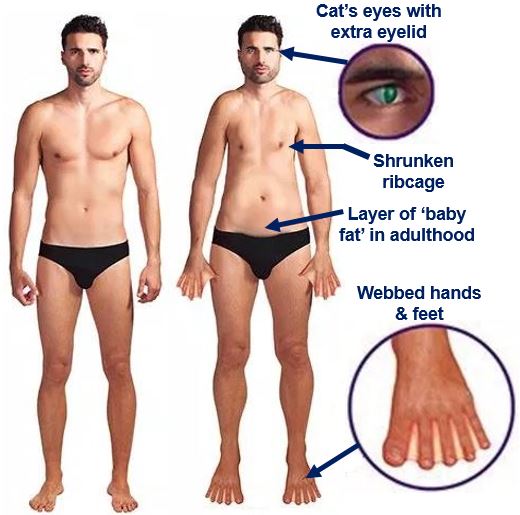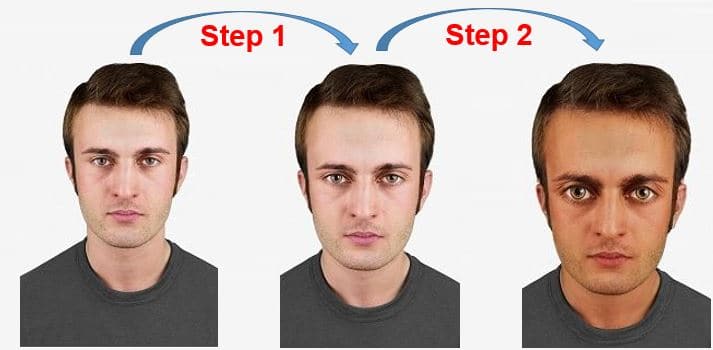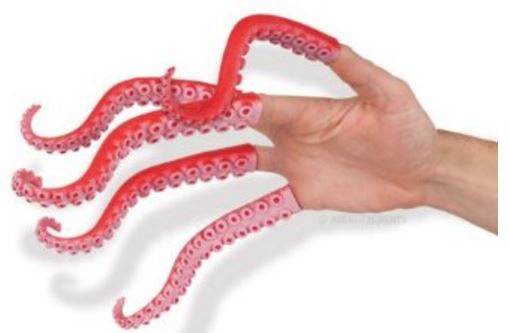Humans will most likely have webbed feet and hands, cat-like eyes, longer fingers and toes for underwater foraging, after climate change causes sea levels to rise and our environment turns more into a water world. We are animals, which evolve. The direction our evolution takes depends on the environment in which we have to survive.
Just as scientists believe our ultra-ancient ancestors were amphibians who moved from the sea to the land, evolution will see future development shifting the other way round, says *paleoanthropologist Dr. Matthew Skinner, Senior Lecturer in Evolutionary Anthropology at the University of Kent’s School of Anthropology & Conservation.
* A paleoanthropologist studies the origins and predecessors of modern humans using fossils and other remains.
Dr. Skinner suggests that human evolution will adapt to a wetter habitat by transforming parts of the body.
 Who knows how we would evolve in a water world? If we started to develop webbed feet, the next step would be to have a tail, like a mermaid. If the change occurred in the top half of the body, with the development of fish eyes and gills to breath under water, the thought of what this could eventually lead to is frightening.
Who knows how we would evolve in a water world? If we started to develop webbed feet, the next step would be to have a tail, like a mermaid. If the change occurred in the top half of the body, with the development of fish eyes and gills to breath under water, the thought of what this could eventually lead to is frightening.
Dr. Skinner said:
“Regular underwater foraging would lead to the evolution of longer fingers and toes which would then likely develop ‘webbed’ interconnecting skin to enable easier swimming.”
“We may evolve a tapetum lucidum, an additional layer in the retina, like cat’s eyes, that would improve our vision in low light conditions such as underwater.”
“Due to the cold environment of being submerged in water regularly, we would maintain a layer of ‘baby fat’ into adulthood as an insulator.”
In the 1995 movie – Waterworld – starring Kevin Costner, humans evolved little gills, webbed feet, and had smaller lungs.
 Dr. Skinner believes our bodies will adapt to rising sea levels by developing amphibian-type features, including webbed feet and hands and cat-like (fish-like) eyes with an extra eyelid.
Dr. Skinner believes our bodies will adapt to rising sea levels by developing amphibian-type features, including webbed feet and hands and cat-like (fish-like) eyes with an extra eyelid.
What if a large asteroid struck Earth?
If a large asteroid struck Earth, our world could be pushed into another ice age. Our planet would be covered with dust, which would reduce the amount of sunlight that could reach the Earth’s surface.
Dr. Skinner believes our skin would become much paler because of the reduced sunlight exposure. We would probably have to produce more of our own vitamin D – we get most of our vitamin D from exposure to sunlight.
A different and colder habitat would probably spur us to develop more body hair and become much more muscular, Dr. Skinner believes.
A different prediction regarding humans in the future
In 2013, designer and researcher Nickolay Lamm collaborated with Dr. Alan Kwan, a computational genomics expert from Washington University, to hypothesize what humans might look like in the future.
 Predictions made by Lamm and Kwan differ significantly from those made by Skinner.
Predictions made by Lamm and Kwan differ significantly from those made by Skinner.
Dr. Kwan broke down his forecasts into what we might look like in 20,000, 60,000 and 100,000 years’ time. They were predicated on two fundamental developments:
1. Our living environment will have changed dramatically, and
2. People will have much more control over human evolution and biology, thanks to breakthroughs in genetic engineering. Genetic engineering involves manipulating an organism’s DNA to change its color, shape, behavior, etc. In other words, to change its characteristics (phenotype).
Dr. Kwan and Mr. Lamm concluded that humans will definitely have larger heads, a part of our bodies that scientists say has been getting bigger since the Middle Ages. Over the next thousands of years, the human head will continue to swell to make room for an ever-expanding brain.
Our eyes will grow into Japanese anime-like spheres, as our environments take us further and further away from natural sunlight (even to outer space). As more humans live outside Earth’s protective ozone layer, exposure to UV radiation will increase, resulting in more pigmentation.
As soon as we have gained ‘total mastery over morphological genetics’ – in about 60,000 years’ time – we’ll be manipulating our offsprings’ DNA so that their features are perfect, i.e. straight noses and symmetrical faces, etc.
 Is this the ideal hand for using future ultra hi-tech devices?
Is this the ideal hand for using future ultra hi-tech devices?
As high-tech devices get more sophisticated, good dexterity will become more important. This need for dexterity has already started. We spend more time today touching things with our fingers – smartphones, computer screens, modern medical procedures and medical devices, etc.
Some researchers predict that our fingers will become more sensitive – they will have more nerve endings – and get longer. They believe our fingers will in future will be more like tentacles.
Video – Weird ways we could evolve in the future
There are predictions that our fingers will extend and become like tentacles with considerably more nerve endings because we are spending more and more of our time tapping things like keys on our smartphones and screens. This video looks at several weird predictions.
